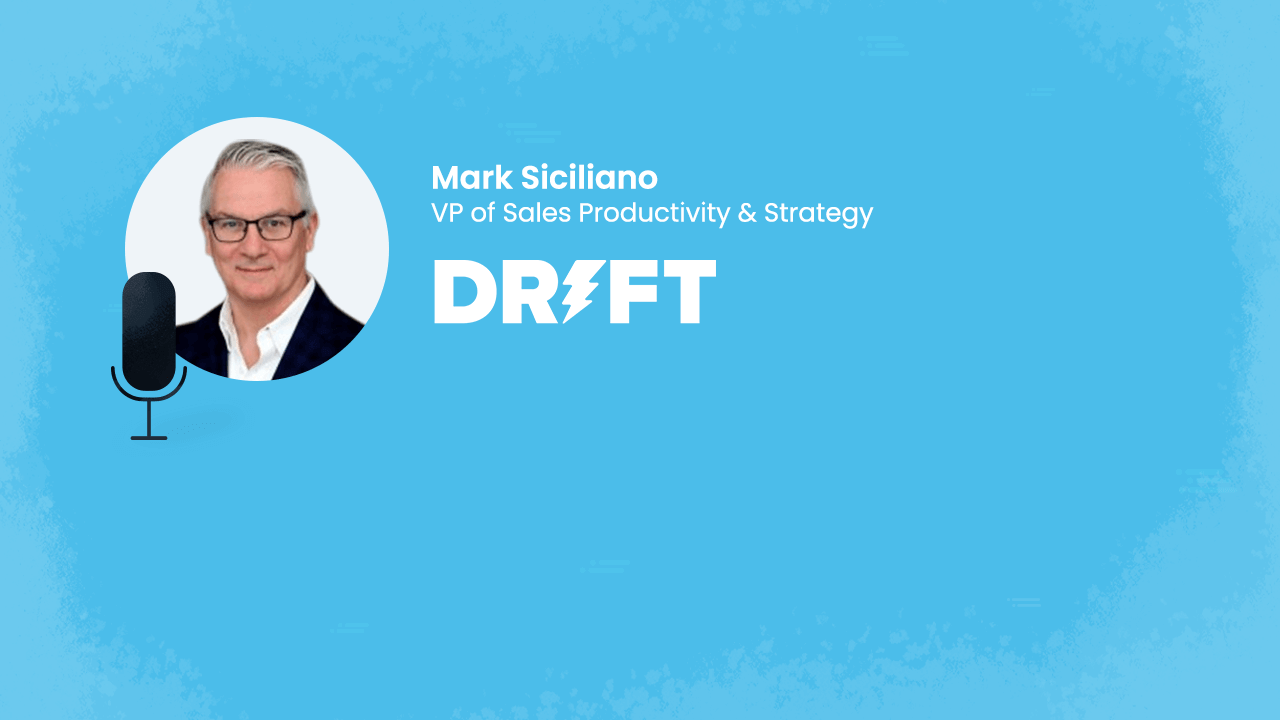With an unmatched number of people working from home (WFH), it can be difficult to maintain motivation. This is especially true for salespeople who are typically surrounded by their peers making cold calls, running demos, and closing deals. I sat down with Mark Siciliano, the VP of Sales Productivity & Strategy at Drift to discuss how he’s keeping his team motivated while working from home.
Graham Collins:
Hey Mark, thank you so much for chatting with me about sales in the “work from home” world. Before we dive in, can you tell our readers a little bit about yourself and Drift?
Mark Siciliano:
Sure, Graham. Happy to be with you. For starters, I joined Drift in August of this year as the VP of Sales Productivity & Strategy. I’ve worked with great SaaS business from Oracle, Marketo, Demandbase, and now Drift. What makes Drift so unusual, was that I was hired while working remotely and onboarding with colleagues I’ve not yet met face to face. And yet there is such a connection. It’s an incredibly exciting time for Drift and it’s been a fantastic experience helping our customers adapt and succeed during a challenging time for all of us.
In case your readers don’t know, Drift is a Revenue Acceleration platform that uses conversational marketing and conversational sales to help our customers grow revenue and increase customer lifetime value faster. In essence, we power the marketing and sales tech for more than 50,000 businesses that enables folks to do their jobs better, smarter, and more effectively, using a platform with AI.
Graham Collins:
Great! Thanks, Mark. Okay, diving in here with my first question. It can be tough to stay motivated to sell while working from home. How do you keep your team motivated during these challenging times?
Mark Siciliano:
It’s a great question, and something that in speaking with other sales professionals, is very top of mind for themselves and their teams. Maintaining motivation and drawing boundaries between work and life has never been more important than it is now.
At Drift, we’ve been working hard to make sure these lines are drawn and our teams feel supported. To do this, we’ve moved a lot of our important employee engagement programs to virtual experiences, including Monday Metrics, when teams can reflect on progress and outline clear priorities for the week. We’re balancing these regular meetings with more casual ones. Recently, we held a virtual “Friends and Family Day” for our entire company, where the team had the opportunity to connect outside of a business setting. These are important initiatives that work in tandem to make sure we can not only align on priorities, but also build camaraderie amongst our team.
In addition, we actually decided to shift our fiscal year end from December 31 to January 31st. This means that our sales team can actually enjoy the holidays — and actually helps our customers focus on their year end, instead of Zoom calls with us!
I think my biggest advice to other managers who are struggling to keep their team motivated during the pandemic is to unite under one goal. For the team at Drift, our goal is to continue innovating for our customers and put them in the center of everything we do. That’s how our company was built, and it’s one of the pillars of our organization.
Graham Collins:
I get asked about hiring and training remote salespeople frequently. I know you were hired remotely, but have you done any hiring and training remotely? If so, what’s your advice for those struggling with it?
Mark Siciliano:
Drift as a company has grown a lot since Q1 – and even in the months since I joined the team. We were incredibly fortunate to even record one of our largest quarters in company history in both Q2 and Q3 of this year. As a result of this momentum, we’ve expanded our team significantly and restructured our internal organization to ensure our employees are supported.
Since joining Drift, I’ve been in charge of remotely hiring and training over 100 people. It’s been a significant undertaking building – and onboarding – our sales leadership team entirely remote. As challenging as it’s been, however, I’m reminded of how lucky we are to be able to hire new talent amidst the pandemic, because I know that’s not the case for a lot of companies this year.
My advice to managers specifically is to be as clear as possible when assigning projects or when giving instructions, and repeat instructions frequently. It seems like such a foundational, basic piece of advice, but when we’re caught up in the day to day, I think sometimes it serves as a helpful reminder to managers and associates alike.
Graham Collins:
For salespeople who are used to being surrounded by their peers on a sales floor every day, transitioning to a remote lifestyle might be a huge change for them. How would you recommend a salesperson acclimates to a fully remote sales role and what virtual team building activities would you recommend?
Mark Siciliano:
I think my biggest recommendation is to ensure that salespeople have very clear channels for communicating with one another. Sales roles center around collaboration and teamwork. These teams are always working with one another to share leads in order to meet sales quotas and goals.
Consistent, effective communication serves as the foundation of any successful team and means even more when working remotely. Of course, this can be much harder when you’re remote and aren’t able to turn to the person next to you to ask for help. This is where sales managers play a role; it’s our responsibility as sales managers to facilitate this virtual collaboration whenever possible.
Graham Collins:
Obviously being a SaaS company, I’m sure you lean on tech to drive engagement with your sales team. How has technology helped you during this time?
Mark Siciliano:
Absolutely. At Drift, we lean on product-led growth as our primary strategy, so technology and functionality are at the heart of everything we do. This is something that has definitely worked, as we grew from $0 in revenue in 2015 to more than eight figures in less than two years.
Something that is quickly becoming the cornerstone of our sales tech stack is our newest product, Drift Prospector. We launched Prospector in August as part of our announcing a new category in enterprise technology: Revenue Acceleration. The beauty of this platform is that it’s a product built for our virtual lives right now. What I mean is that because of social distancing recommendations, the dinners and in-person events we once relied on to build relationships and engage with our customers now aren’t an option. Instead, we leverage technology to our advantage to meet customers on their terms, and establish that essential visibility to see when outbounds are being engaged with.
Prospector works for sales teams by helping them navigate the omnichannel, virtual sales environment – LinkedIn, Salesforce, Outreach, etc. – by aggregating all of these disparate touchpoints under one platform. Thus providing visibility into how prospects are engaging with outbounds.
Right now, it’s all about removing friction from the buying process and creating impactful digital experiences for current and prospective customers alike. As the adaptation that the pandemic started with slowly turns into normal behavior, sales teams will need to increasingly rely on technology like Prospector, to better engage customers on their terms, 24/7/365.
Graham Collins:
Any other tips and tricks you might recommend for a salesperson working from home for the first time?
Mark Siciliano:
Definitely, I have a couple that immediately come to mind:
My first piece of advice for an AE is: relate to the pain. 2020 has been a difficult time for all of us, and sales teams need to be mindful and attentive to the situations our prospects and customers are in. This year we’ve all experienced a great trauma, and unless we can relate to that pain and connect to illustrate the “why now” of a buying decision, your sales pitch will be meaningless. Creating that sense of alignment is essential now to show prospects that you understand their pain points.
My other tip is to put the customer at the center of everything you do. I’ve alluded to this already – and it might sound complex, but it’s really not. In order to succeed now – in sales and really every profession – we need to think about our customers foremost. Think with every decision, “what is the value for my customers?” If you can adopt this mindset, then remote work or in person, you’ll set yourself up for success. This is our mentality at Drift, and something that’s been vital to our success since the beginning.
Graham Collins:
Thank you again for your time, Mark. Where can people find you — and Drift — online?
Mark Siciliano:
Thank you for your time as well, Graham. Our website is www.drift.com. While there, we have a great blog with a lot of really helpful resources that everyone should check out, as well as Drift Insider — our learning platform. You can also catch us on Twitter @Drift and on LinkedIn and me at @MarkSiciliano61 on Twitter and on LinkedIn.



